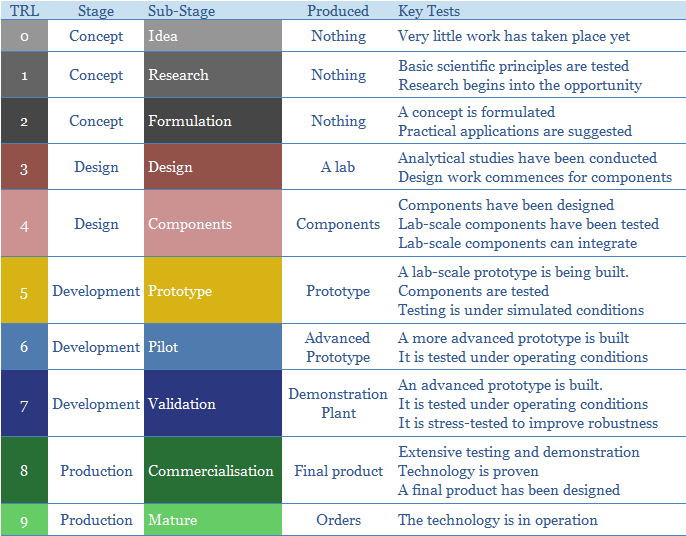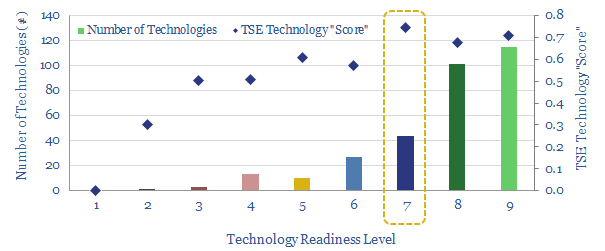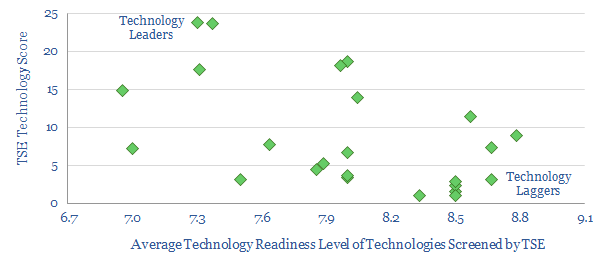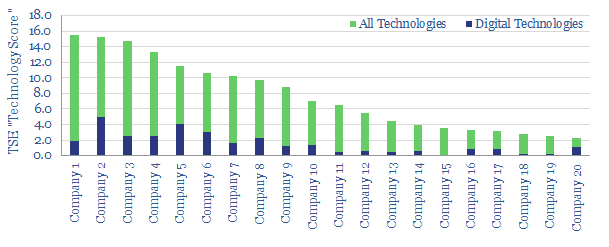We categorised 300 of the Oil Majors’ technologies according to their technical maturity. We find the most exciting examples are not the most technically mature, but those on the cusp of commercialisation. Majors that work on earlier-stage technologies also have better overall technologies (c50% correlation coefficient). Hence, to create value, it is important to maintain a constant funnel of technology opportunities.
When we assess an energy technology, we score it on four dimensions: how far does it advance the industry-standard? How large is the potential economic impact? How proprietary is it? And finally, is it “ready”?
To quantify the final category, we use the industry-standard conceptual framework of ‘Technology Readiness Levels’ (TRLs), which are summarised below. It is worth being familiar with this categorization, as it recurs throughout our work.

But when do technologies get exciting?
To some extent, “excitement” depends upon your perspective. Venture funds may find most value on the earlier rungs of the ladder. But most companies and investors get excited in the later stages. We can measure this. The results are surprising.
Below, we have summarised our “TSE Technology Scores” for 300 technologies, used by the 25 oil and gas companies that we follow. The highest scores appear to be for technologies at Readiness Level Seven (chart below).

Even though these technologies are less mature than TRLs 8-9, we think they are more exciting. This is unexpected. As discussed above, our “Technology Scores” specifically award higher marks to more mature technologies, and penalise those that are less mature.
On the other hand, maybe it is not so surprising. Opportunities at TRL7 are, by definition, new and cutting-edge. Conversely, the shine tends to wear off for more mature technologies, that have already spread around the industry.
What does it means for companies?
If the most exciting technologies are the ones on the cusp of commercialisation, it is important that leading companies can embrace them. We think the answer is to maintain a rich funnel of opportunities, including those at earlier stages. Our data suggest that the technology-leaders around the industry are doing exactly this…
Below, we rank the 25 oil and gas companies that we follow. We find a 50% correlation between the companies that are working on ‘earlier stage’ technologies and those that have better overall technologies.

Investable insights. To develop a lead in technology, you have to be involved in developing technology. If your sole approach is to buy mature technologies off the shelf, you will only access them later, and with less theoretical context than the leaders. We think this explains the correlation above. We also think it matters for investing in the best energy companies, where technical capabilities are starkly different (below).

How can we help? For our full database of 300 technologies, scores by company, or by industry sub-segment, please contact us. We can also provide consultancy services on your company, highlighting areas where there is most scope for improvement, by reference to peers’ best-practices.
